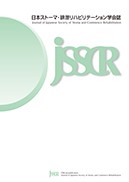Volume 24, Issue 2
Total63
Displaying 1-25 of 25 articles from this issue
- |<
- <
- 1
- >
- >|
-
2008Volume 24Issue 2 Pages 0
Published: 2008
Released on J-STAGE: October 30, 2021
Download PDF (553K)
-
2008Volume 24Issue 2 Pages S1
Published: 2008
Released on J-STAGE: October 30, 2021
Download PDF (688K)
-
2008Volume 24Issue 2 Pages S2
Published: 2008
Released on J-STAGE: October 30, 2021
Download PDF (722K)
-
2008Volume 24Issue 2 Pages S3-S4
Published: 2008
Released on J-STAGE: October 30, 2021
Download PDF (1465K)
-
2008Volume 24Issue 2 Pages 1-6
Published: 2008
Released on J-STAGE: October 30, 2021
Download PDF (4007K) -
2008Volume 24Issue 2 Pages 7-11
Published: 2008
Released on J-STAGE: October 30, 2021
Download PDF (4109K)
-
2008Volume 24Issue 2 Pages S5
Published: 2008
Released on J-STAGE: October 30, 2021
Download PDF (433K) -
2008Volume 24Issue 2 Pages 13-17
Published: 2008
Released on J-STAGE: October 30, 2021
Download PDF (3385K) -
2008Volume 24Issue 2 Pages 18-26
Published: 2008
Released on J-STAGE: October 30, 2021
Download PDF (5313K) -
2008Volume 24Issue 2 Pages 27-33
Published: 2008
Released on J-STAGE: October 30, 2021
Download PDF (4947K) -
2008Volume 24Issue 2 Pages 34-38
Published: 2008
Released on J-STAGE: October 30, 2021
Download PDF (3837K)
-
2008Volume 24Issue 2 Pages 39
Published: 2008
Released on J-STAGE: October 30, 2021
Download PDF (818K) -
2008Volume 24Issue 2 Pages 41-44
Published: 2008
Released on J-STAGE: October 30, 2021
Download PDF (2597K) -
2008Volume 24Issue 2 Pages 45-49
Published: 2008
Released on J-STAGE: October 30, 2021
Download PDF (3381K) -
2008Volume 24Issue 2 Pages 50-56
Published: 2008
Released on J-STAGE: October 30, 2021
Download PDF (5240K) -
2008Volume 24Issue 2 Pages 57-60
Published: 2008
Released on J-STAGE: October 30, 2021
Download PDF (3205K) -
2008Volume 24Issue 2 Pages 61-63
Published: 2008
Released on J-STAGE: October 30, 2021
Download PDF (2108K)
-
2008Volume 24Issue 2 Pages 65-83
Published: 2008
Released on J-STAGE: October 30, 2021
Download PDF (14705K) -
2008Volume 24Issue 2 Pages 84-87
Published: 2008
Released on J-STAGE: October 30, 2021
Download PDF (3111K) -
2008Volume 24Issue 2 Pages 88-92
Published: 2008
Released on J-STAGE: October 30, 2021
Download PDF (4204K) -
2008Volume 24Issue 2 Pages 93-96
Published: 2008
Released on J-STAGE: October 30, 2021
Download PDF (3298K) -
2008Volume 24Issue 2 Pages 97-100
Published: 2008
Released on J-STAGE: October 30, 2021
Download PDF (3393K) -
2008Volume 24Issue 2 Pages 101-104
Published: 2008
Released on J-STAGE: October 30, 2021
Download PDF (1951K) -
2008Volume 24Issue 2 Pages 105-108
Published: 2008
Released on J-STAGE: October 30, 2021
Download PDF (3529K)
-
2008Volume 24Issue 2 Pages E1
Published: 2008
Released on J-STAGE: October 30, 2021
Download PDF (371K)
- |<
- <
- 1
- >
- >|
